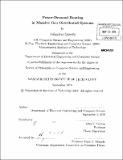| dc.contributor.advisor | John V. Guttag. | en_US |
| dc.contributor.author | Qureshi, Asfandyar | en_US |
| dc.contributor.other | Massachusetts Institute of Technology. Dept. of Electrical Engineering and Computer Science. | en_US |
| dc.date.accessioned | 2011-04-25T15:57:32Z | |
| dc.date.available | 2011-04-25T15:57:32Z | |
| dc.date.copyright | 2010 | en_US |
| dc.date.issued | 2010 | en_US |
| dc.identifier.uri | http://hdl.handle.net/1721.1/62430 | |
| dc.description | Thesis (Ph. D.)--Massachusetts Institute of Technology, Dept. of Electrical Engineering and Computer Science, 2010. | en_US |
| dc.description | Cataloged from PDF version of thesis. | en_US |
| dc.description | Includes bibliographical references (p. 165-171). | en_US |
| dc.description.abstract | There is an increasing trend toward massive, geographically distributed systems. The largest Internet companies operate hundreds of thousands of servers in multiple geographic locations, and are growing at a fast clip. A single system's servers and data centers can consume many megawatts of electricity, as much as tens of thousands of US homes. Two important concerns have arisen: rising electric bills; and growing carbon footprints. Our work develops a new traffic engineering technique that can be used to address both these areas of concern. We introduce Power-Demand Routing (PDR), a technique that redistributes traffic between replicas with the express purpose of spatially redistributing the system's power consumption, in order to reduce operating costs. Cost can be described in monetary terms or in terms of pollution. Within existing Internet services, each client request requires a meaningful amount of marginal energy at the server. Thus, by rerouting requests from a server at one geographic location to another, we can spatially shift the systems marginal power consumption at Internet speeds. We show how PDR can be used to reduce electric bills. We describe how to couple request routing policy to real-time price signals from wholesale electricity markets. In response to price-differentials, PDR skews client load across a system's clusters and pushes server power-demand into the least expensive regions. Our analysis quantifies the potential reduction in energy costs. We use simulations driven by empirical data and models: we collected a real-world request traffic workload in collaboration with Akamai; constructed data center energy models; and compiled a database of historical electricity market prices. We conclude that existing systems can use PDR to cut their annual electric bills by millions of dollars. We also show how PDR can be used to reduce carbon footprints. Not all joules are created equal and in power pools like the grid the environmental impact per joule varies geographically and in time. We show how to construct carbon cost functions that can be used with PDR to dynamically push a system's power-demand toward clean energy. | en_US |
| dc.description.statementofresponsibility | by Asfandyar Qureshi. | en_US |
| dc.format.extent | 171 p. | en_US |
| dc.language.iso | eng | en_US |
| dc.publisher | Massachusetts Institute of Technology | en_US |
| dc.rights | M.I.T. theses are protected by
copyright. They may be viewed from this source for any purpose, but
reproduction or distribution in any format is prohibited without written
permission. See provided URL for inquiries about permission. | en_US |
| dc.rights.uri | http://dspace.mit.edu/handle/1721.1/7582 | en_US |
| dc.subject | Electrical Engineering and Computer Science. | en_US |
| dc.title | Power-Demand Routing in massive geo-distributed systems | en_US |
| dc.title.alternative | PDR in massive geo-distributed systems | en_US |
| dc.type | Thesis | en_US |
| dc.description.degree | Ph.D. | en_US |
| dc.contributor.department | Massachusetts Institute of Technology. Department of Electrical Engineering and Computer Science | |
| dc.identifier.oclc | 710993386 | en_US |
